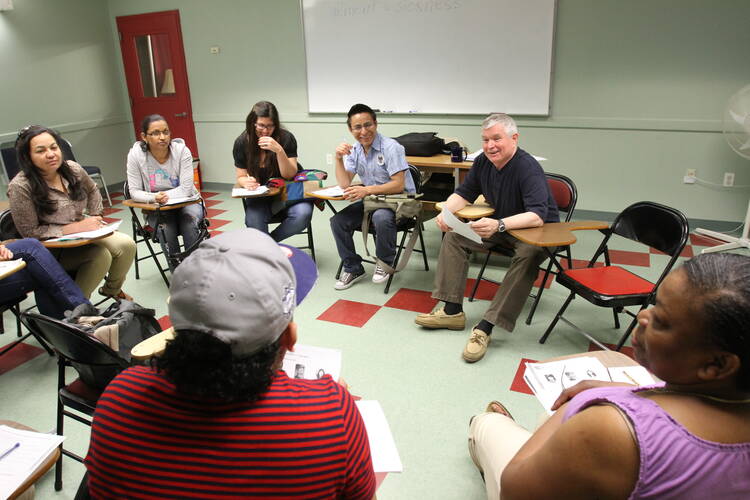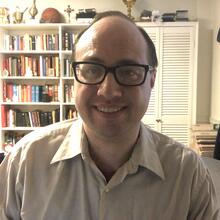Mary McGinnity is a former psychologist, educator and longtime Catholic curial lay employee who serves as president and C.E.O. of the Ignatian Volunteer Corps (I.V.C.), a service organization of more than 500 semi-retired and retired Catholics serving as skilled volunteers in nonprofits and charities in 17 regions across the United States.
Based in Baltimore, where Jim Conroy, S.J. and Charlie Costello, S.J. founded it in September 1995 to encourage lay-led ministry, the I.V.C. celebrates its 25th anniversary this year. While Catholics have debated in recent years about “the Benedict option,” a plan that Eastern Orthodox author Rod Dreher proposes for Christians to withdraw into prophetic cells within society after the monastic example of St. Benedict, the I.V.C.’s full-immersion engagement with society represents what may be called “the Ignatius option.”
On Feb. 25, I interviewed Ms. McGinnity by telephone about the I.V.C. anniversary and her perspective on the work. The following transcript of our conversation has been edited for style and length.
The I.V.C. just celebrated its 25th anniversary. How do you describe the I.V.C. to people?
It is a service corps that mobilizes the gifts and talents of professional adults over 50 who are retired on behalf of people who are in poverty and who are marginalized. Because of that, I.V.C. transforms lives, community and society through the strengths of service and spirituality.
I.V.C. transforms lives, community and society through the strengths of service and spirituality.
People often see I.V.C. as the non-residential version of a Christian service program for young adults. How does I.V.C. differ from a young adult service program?
The I.V.C. service corps of men and women serve in the communities where they live, so they stay in their own communities. Another difference is they gather regularly for retreats and monthly spiritual support meetings. So they form small faith communities rooted in Ignatian spirituality. The other big difference is that I.V.C. volunteers stay in their service sites for several years. Unlike the one to two years of young adult service programs, I.V.C. volunteers average seven to ten years, providing a tremendous amount of stability to these organizations. Many of them reinvent their lives with new meaning and purpose, bringing it back into the community to enhance the community.
As you mentioned, your program draws many people from accomplished professional backgrounds. What is the profile of an average I.V.C. volunteer?
Your typical male service corps member has been a career professional, usually with a postgraduate education, and many have been Jesuit-educated. They have finished careers as doctors, lawyers, engineers, social workers, educators, small business owners, accountants and so on. Women also include that level of professionalism, with higher career levels, but we also have women who have lived as full-time moms and grandmothers. That number is becoming fewer and fewer as we see more health care workers, special education teachers and professional women.
How have your own professional and personal backgrounds influenced the gifts you bring to I.V.C.?
My paths of my career, every single dimension, gave me a nice complexity of skills to run I.V.C. as a national organization. I started my young adult life as a Jesuit volunteer after graduating from Holy Cross. The integration of service and faith led me to work as a teacher in Newark, where I saw the need to strengthen families where kids grow up. So I went on to study therapy, studying family systems as a pastoral psychotherapist with a parish-based clinical practice that we ran in northern New Jersey for 18 years, seeing 150 families and individuals a week. Then I moved back to my native Maryland and decided to study for the public sector, serving as the senior aide to the director of health and human services in Montgomery County, where I learned the public policy world. Then I became the director of justice and service for the Archdiocese of Washington.
So you can see all of the experiences that came together when I arrived as a board member at I.V.C. in 2008, when the national recession destroyed 38 percent of the nonprofits that served the poor. The board asked me to step in and steer the ship, which took all of my resources.
Reflecting on your past 10 years of leading I.V.C., what have been some personal highlights?
First of all, the biggest highlight to me has been watching the men and women in the communities who want I.V.C. When I started, we only had 200 people around the country who worried we were going to close, but I saw their passion for what I.V.C. does [at] the intersection of spirituality and service at the margins. The other highlight has been watching a lay-led board commit themselves to this work of the Society of Jesus, committing themselves as laity to this work that two Jesuits started. Finally, the most important highlight has been watching with joy the tears and extreme gratitude... what these corps members have brought to more than 450 nonprofits on the front line[s] of where people struggle. It’s also been phenomenal to see the laity become professional ministers in the church.
It’s been phenomenal to see the laity become professional ministers in the church.
What have been some challenges of your tenure?
Mobilizing the gifts of philanthropic support to this organization while it’s been under construction has been a challenge. I came in to rehab a whole organization without much financial support, so I had to go out begging. Sometimes I feel like St. Francis of Assisi or St. Ignatius going out to people. We are in the business of generosity and compassion; I rely on people’s hearts and generosity. I always need that generosity to be materialized. Nothing is more powerful to me than the pure joy and grace of seeing that generosity, but I’ve also had a lot of “no’s” from people who don’t want to invest in us because we don’t have much money. Asking for something I love so much and hearing “no” is not unlike a mother asking [for] money to feed a kid she loves so much.
The I.V.C.’s two Jesuit founders evoked the ecclesial vision of Vatican II when they started the organization, hoping to empower Catholics from more clericalized generations to see themselves as lay ministers in a true sense. In what ways do you still see I.V.C. empowering Catholic laity to take ownership of the church, especially in this time when clerical leadership seems to have failed us in the abuse crisis?
I tell people that from where I sit, against the backdrop of the abuses of the hierarchy, I see the Holy Spirit and the story of new wine in old wineskins happening. Jim Conroy and Charlie Costello, the two Jesuits who started I.V.C., sat down with three documents to come up with this concept: the documents of Vatican II, the Scriptures and the documents of the most recent General Congregation of the Society of Jesus. The lay leadership Pope Francis talks about—we’re doing it, in collaboration with Jesuits as spiritual guides and leaders of institutions, like Cristo Rey, where we serve in partnership. Vowed religious, clergy and laity are doing something remarkable as collaborators, and that’s the new church. If that ever makes its way into the hierarchy, it will be powerful.
In your view, what remains “Ignatian” today about the Ignatian Volunteer Corps?
Truly finding God in all things, to be in [a] relationship where Christ called us to serve the poor, to be men and women for others—that’s it in a nugget right there. We’re not just saying it, we’re doing it where it’s hardest, being with people who aren’t like us and who are hard to be around. It’s an adventure to go out there on mission to places that need love with the homeless, the poor, the refugees. Our men and women come from the core of privilege; they’ve had many blessings, and they want to give back. They now interact with people they normally wouldn’t be around, embracing it with love as it makes them stretch. That’s what I personally love about Ignatian spirituality, the practical theology that challenges us to be on mission to the margins.
Ignatian spirituality is a practical theology that challenges us to be on mission to the margins.
What advice would you give to someone who is interested in learning more about I.V.C. and possibly joining?
Send us an email, get into conversation with us, but know that we respect discernment and calling. We have a whole discernment process to help people decide if it’s right for them. Pick up the phone and call. If God is leading your heart in this direction, give it a chance.
Pope Francis has often spoken about the tendency of our youth-obsessed society to discard the elderly rather than listen to their wisdom. How do you see I.V.C. fulfilling his vision of older Catholics serving as mentors and role models for younger generations?
First of all, I never use the term “elderly.” Our service corps members are vital, vibrant, energized and wise. They’re full of wisdom and experience that is so valuable, even though it’s not something our society often honors. We embrace it, acknowledge it and celebrate it as a gift. We invite people in the third chapters of their lives to celebrate this gift of wisdom. We’re not just youth-oriented, but product-oriented, always asking what someone will give us. But sometimes the biggest gift is the gift of self, offering ourselves out into the world where it’s needed most.
What regrets, if any, do you have about the first 25 years of I.V.C.?
Since I’m a fanatical optimist, it’s hard for me to focus on regrets. I would say listening too much to doubters or naysayers, and not reaching out to ask for more support faster and sooner, is a personal thing for me. It took me a long time to get over myself and be comfortable in the role of “chief begging officer,” of being in that position of asking and inviting material support. It’s very hard.
We need to be the church that reflects the healing face of Christ on the streets.
What are your goals for the next 25 years of I.V.C.?
With the arc of the boomer generation entering into retirement, and with I.V.C. now firmly established, we could be 10 times bigger in 25 years, with 6,000 men and women in many more cities. We just need the capital. As we grow, we want to make sure our spirituality component remains very strong and of the highest quality, rich and ongoing. The goal is to grow and grow robustly. Our country right now, in all of this divisiveness, needs places where we can build and grow together. That’s what I.V.C. does, it brings people together who normally wouldn’t interact, and we need to be the church that reflects the healing face of Christ on the streets.
Sean Salai, S.J., is a special contributor at America.









